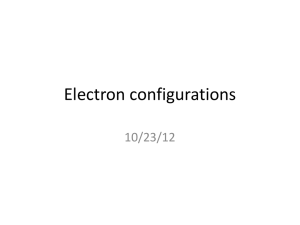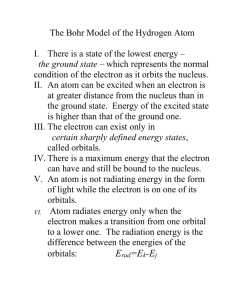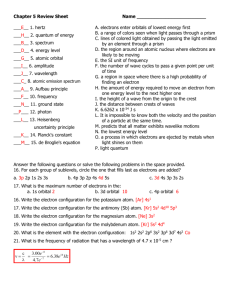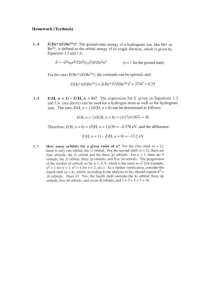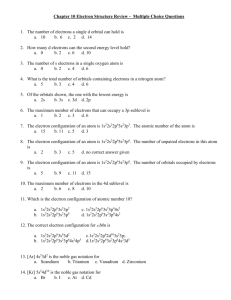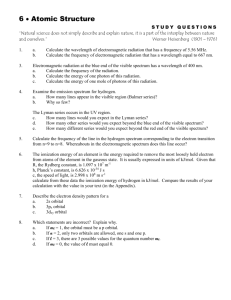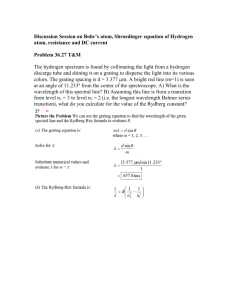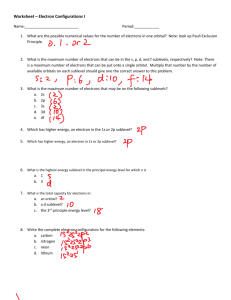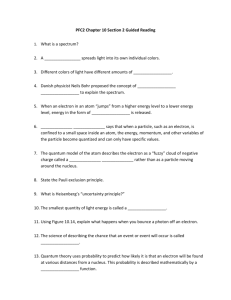AP Chem Independent Study: CH 6- Electronic Structure of the Atom
advertisement
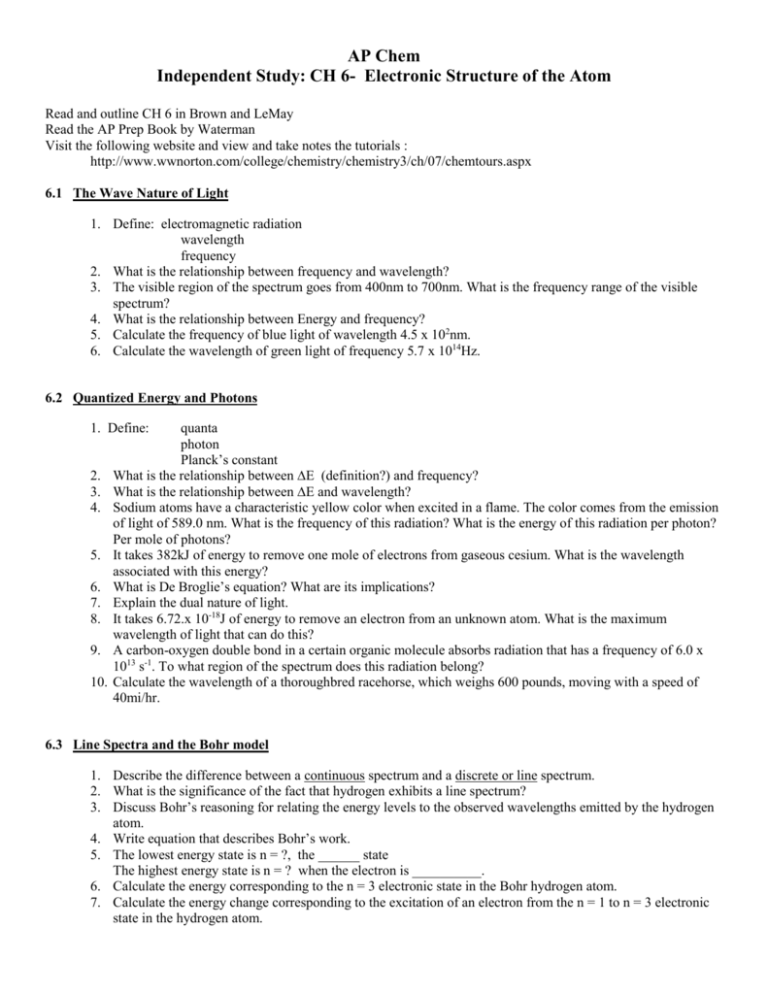
AP Chem Independent Study: CH 6- Electronic Structure of the Atom Read and outline CH 6 in Brown and LeMay Read the AP Prep Book by Waterman Visit the following website and view and take notes the tutorials : http://www.wwnorton.com/college/chemistry/chemistry3/ch/07/chemtours.aspx 6.1 The Wave Nature of Light 1. Define: electromagnetic radiation wavelength frequency 2. What is the relationship between frequency and wavelength? 3. The visible region of the spectrum goes from 400nm to 700nm. What is the frequency range of the visible spectrum? 4. What is the relationship between Energy and frequency? 5. Calculate the frequency of blue light of wavelength 4.5 x 102nm. 6. Calculate the wavelength of green light of frequency 5.7 x 1014Hz. 6.2 Quantized Energy and Photons 1. Define: 2. 3. 4. 5. 6. 7. 8. 9. 10. quanta photon Planck’s constant What is the relationship between ∆E (definition?) and frequency? What is the relationship between ∆E and wavelength? Sodium atoms have a characteristic yellow color when excited in a flame. The color comes from the emission of light of 589.0 nm. What is the frequency of this radiation? What is the energy of this radiation per photon? Per mole of photons? It takes 382kJ of energy to remove one mole of electrons from gaseous cesium. What is the wavelength associated with this energy? What is De Broglie’s equation? What are its implications? Explain the dual nature of light. It takes 6.72.x 10-18J of energy to remove an electron from an unknown atom. What is the maximum wavelength of light that can do this? A carbon-oxygen double bond in a certain organic molecule absorbs radiation that has a frequency of 6.0 x 1013 s-1. To what region of the spectrum does this radiation belong? Calculate the wavelength of a thoroughbred racehorse, which weighs 600 pounds, moving with a speed of 40mi/hr. 6.3 Line Spectra and the Bohr model 1. Describe the difference between a continuous spectrum and a discrete or line spectrum. 2. What is the significance of the fact that hydrogen exhibits a line spectrum? 3. Discuss Bohr’s reasoning for relating the energy levels to the observed wavelengths emitted by the hydrogen atom. 4. Write equation that describes Bohr’s work. 5. The lowest energy state is n = ?, the ______ state The highest energy state is n = ? when the electron is __________. 6. Calculate the energy corresponding to the n = 3 electronic state in the Bohr hydrogen atom. 7. Calculate the energy change corresponding to the excitation of an electron from the n = 1 to n = 3 electronic state in the hydrogen atom. 8. What wavelength of electromagnetic radiation is associated with the energy change in promoting an electron from the n = 1 to n = 3 level in the hydrogen atom? (Use the value of ∆E from the previous question) 9. How much energy is required to ionize a mole of hydrogen atoms? 10. What region of the spectrum would you look in to find the radiation associated with the spectral transition of n =3 to n = 2 in the hydrogen atom. 11. What is the difference between the Lyman, Balmer, Paschen Brackett and Pfund Series? 6.4 The Wave Behavior of Matter Key assumption: the electron is assumed to behave as a standing wave. Only certain orbits are shaped such that the “wave” (electron) can fit. The wave function of an electron represents the allowed coordinates where the electron may reside in the atom. Each wave function is called an orbital. 1. What is Heisenberg’s Uncertainty Principle? 2. How is the limit of the size of an atom defined? 6.5 Quantum Mechanics and Atomic Orbitals Complete the following table describing quantum numbers: Name Designation Property of the orbital n Related to _____ and ______ of orbital l Related to the ______of the orbital ml Related to the position of the orbital in space relative to other orbitals s Related to __________ of electron Possible range of values 1. Which of the following sets of quantum numbers are not allowed in the hydrogen atom? For each incorrect set, state why it is incorrect. a) n = 1, l = 0, m = 1 b) n = 2, l = 2, m = 1 c) n = 5, l = 3, m = 2 d) n = 6, l = -2 m = 2 e) n = 6, l = 2, m = -2 6.6 Representations of Orbitals 1. 2. 3. 4. 5. 6. How do the three 2p orbitals differ from one another? In what ways do d- orbitals differ from p orbitals? Why doesn’t a 2d orbital exist? What is the chemical meaning of a “degenerate”? What is meant by “ground state”? How can a 1s electron be excited to a higher energy level? 6.7 The Many Electron Atom 1. What property of an electron does the quantum number given by ms represent? 2. What is the Pauli Exclusion Principle? What is its consequence regarding the number of electrons that an orbital can hold? 3. If each orbital can hold a maximum of two electrons (of opposite spin) how many electrons can each of the following hold? a. b. c. d. e. 2s 5p 4f 3d 4d 6.8 Electron Configurations 1. 2. 4. 5. What is electron configuration? What Hund’s Rule? What is the Aufbau principle? When constructing orbital diagrams: a. Electrons fill in order from ______ to ________ energy b. The ________ Exclusion principle applies. An orbital can only hold _____ electrons. c. Two electrons in the same orbital must have _____ _______. d. s orbitals can hold ______ electrons p orbitals can hold ______ electrons d orbitals can hold ______ electrons f orbitals can hold ______ electrons e If Hund’s rule applies. The lowest energy configuration for an atom is the one having the maximum number of _____ electrons for a set of _______ orbitals. By convention, all unpaired electrons are represented as having parallel spins with the spin ______. 6. Write electron configurations for each of the following neutral atoms a boron b sulfur c vanadium d iodine 7. What is meant by a kernel, or shorthand electron configuration? 8. Draw the orbital diagrams for the first 3 elements. 9. What is significant in terms of electron configuration about the different families on the periodic table: Alkali metals, Alkaline Earth metals, Transition metals, Halogens, Inert gases and the Lanthanides and the Actinides? 10. What is the electron configurations for Cr and Cu (be careful they are exceptions to the rule) 11. How many ½ filled orbitals do the following have in the ground state? a O b B c Ar d Mn e K f Cf g Zn

